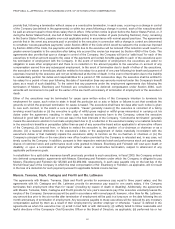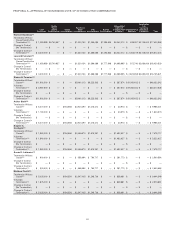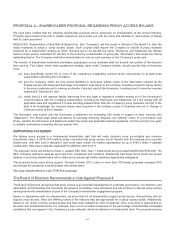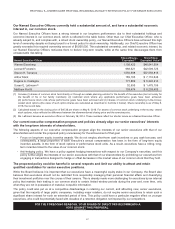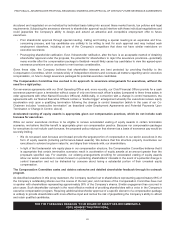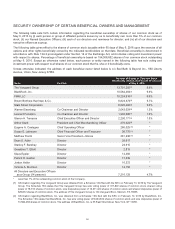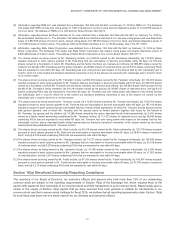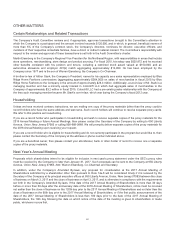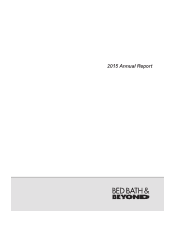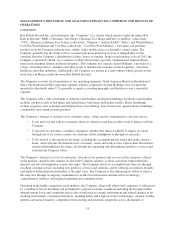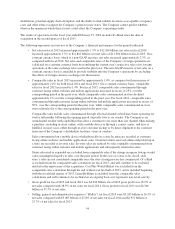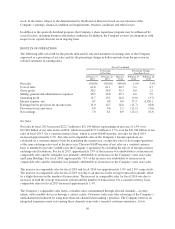Bed, Bath and Beyond 2015 Annual Report Download - page 59
Download and view the complete annual report
Please find page 59 of the 2015 Bed, Bath and Beyond annual report below. You can navigate through the pages in the report by either clicking on the pages listed below, or by using the keyword search tool below to find specific information within the annual report.
PROPOSAL 6—SHAREHOLDER PROPOSAL REGARDING SHAREHOLDER APPROVAL OF CERTAIN FUTURE SEVERANCE AGREEMENTS
structured and negotiated on an individual by individual basis taking into account these market trends, tax policies and legal
requirements. Subjecting the severance element to shareholder approval would interfere with these individual negotiations and
could jeopardize the Company’s ability to design and extend an attractive and competitive employment offer to future
executives.
• Prior shareholder approval through special meeting. Calling and holding a special meeting is an expensive and time-
consuming process, and top candidates are unlikely to be willing to wait for such approval and may instead seek
employment elsewhere, including at one of the Company’s competitors that does not have similar restrictions on
executive severance.
• Post-signing shareholder ratification. Even if shareholder ratification, after the fact, is an acceptable method of obtaining
shareholder approval under the proposal, the potential for shareholders to reject the severance provisions—potentially
many months after the compensation package is finalized—would likely cause top candidates to view the agreed-upon
severance provisions as too uncertain to merit serious consideration.
Given these risks, the Company believes that shareholder interests are best protected by providing flexibility to the
Compensation Committee, which consists solely of independent directors and oversees all matters regarding senior executive
compensation, on how to design severance packages for potential executive candidates.
The Compensation Committee has evolved in its approach to severance arrangements for executives, without the
need for a rigid policy.
Our severance agreements with our Chief Operating Officer and, more recently, our Chief Financial Officer provide for a cash
severance payment upon a termination without cause of only one times each officer’s salary (compared to three times salary in
older agreements with other Named Executive Officers). Additionally, in connection with a change in control transaction, the
agreements with our Named Executive Officers contain a “double trigger” arrangement whereby the executives receive equity
acceleration only upon a qualifying termination following the change in control transaction (which in the case of our Co-
Chairmen includes “constructive termination” as described under Employment Agreements and Potential Payments Upon
Termination or Change in Control, above).
Accelerated vesting of equity awards is appropriate given our compensation practices, which do not include cash
bonuses for executives.
While our senior executives continue to be eligible to receive accelerated vesting of equity awards in certain termination
scenarios, we believe that this benefit is appropriate given our compensation practice. Because our compensation packages
for executives do not include cash bonuses, the proposed policy relying on that element as a basis of severance pay would be
severely limiting.
• We do not award cash bonuses and instead provide the largest portion of compensation to our senior executives in the
form of equity awards (including performance-based awards). We believe that this structure properly incentivizes our
executives to achieve long-term value for, and aligns their interests with, our shareholders.
• In light of the fundamental role equity plays in our compensation structure, the Compensation Committee believes that it
is appropriate that certain termination scenarios result in acceleration of equity awards at an amount greater than the
proposal’s specified cap. For example, our existing arrangements providing for accelerated vesting of equity awards
allow our senior executives to remain focused on protecting shareholders’ interests in the event of a potential change in
control transaction and not be distracted by concerns about losing a substantial portion of their unvested equity
compensation.
The Compensation Committee seeks and obtains extensive and detailed shareholder feedback through its outreach
program.
As described elsewhere in this proxy statement, the Company reached out to shareholders representing approximately 68% of
the Company’s outstanding shares over the course of the last year, and members of the Compensation Committee have met
or spoken with shareholders representing approximately 50% of the Company’s shares. Similar engagement has occurred in
prior years. Such shareholder outreach is the most effective method of providing shareholders with a voice in the Company’s
executive compensation program. Requiring additional shareholder approval of a specific element of a compensation package
is unlikely to provide shareholders with more effective input and carries the risk of jeopardizing the Company’s ability to attract
and retain qualified candidates.
FOR THE FOREGOING REASONS, YOUR BOARD OF DIRECTORS RECOMMENDS A
VOTE AGAINST THIS PROPOSAL.
49



